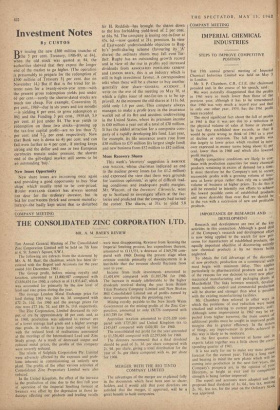Investment Notes
By CUSTOS
BY issuing the new £300 million tranche. of the 5 per cent. Treasury, 1986-89, at 841, when the old stock was quoted at 84, the • authorities showed that they expect the longer end of the market to go higher. (The operation is, presumably to prepare for the redemption of £300 million of Treasury 5f per cent. due on November 14.) But if that is the trend for in- terest rates for a twenty-seven-year term-with the present gross redemption yields just • under , 61- per cent-surely the shorter-dated .stocks are much too cheap. For example, Conversion 31 per cent., 1969-due in six years and ten months -is yielding 6 per cent. to gross redemption at 861 and the Funding 3 per cent., 1959-69, 5.9 " per cent. at just under 84. The true yields to redemption on these two stocks-grossing up the tax-free capital profit-are no less than 74
per cent, and 7 per cent. respectively. Now that Bank rate is down to 44 per cent. and can fall even further to 4 per cent., if sterling keeps strong and the dollar and one or two European currencies remain under pressure, the shorter end of the gilt-edged market still seems to be an outstanding `buy.'
New Issues Opportunity
New share issues are increasing once again and providing a good opportunity to buy `blue chips' which usually tend to be over-priced. RUGBY PORTLAND CEMENT has always Seemed too dear for the • ordinary investor, but its bid for EasTwooDs (brick and cement, manufac- turers),-the badly kept secret that so diSturbed Sir H. Reddish-has brought the shares down to the less forbidding yield-level of 2 per cent. at 64s. 9d. The company is issuing one-in-four at 45s. 6d.-now quoted at 21s. premium. In view of Eastwoods' understandable objection to Rug- by's' profit-sharing scheme (favouring its `tA' shares) the ordinary shares may fall eyed (fur- ther. Rugby has an outstanding growth record and in view of the rise in profits and increased dividends from ASSOCIATED PORTLAND CEMENT and LONDON BRICK, this is an industry which is still in high investment favour..A correspondent asks when there will be a chance to buy another generally dear share-GENERAL ACCIDENT . I write on the eve of the meeting on May 10, at which a rights issue of one-for-ten is to be ap- proved. At the moment the old shares at Ills. 6d, yield only 1.4 per cent. This company always manages to make a profit (rare in the insurance world) out of its fire and accident underwriting in the United States, where its premium income is £40 million a year out of a total of £70 million. It has the added attraction for a composite corn- panynf a rapidly developing life fund. Last year, for example,, its life assurance assets rose from £30 million to £35 million (its largest single fund) and new business from £52 million to £82 million.
More Recovery, Shares
This week's `recovery' suggestion is BABCOCK AND WILCOX, whose chairman indicated an end to the nuclear power losses (so far £1.2 million) and expressed the view that there were grounds for .`cautious optimism,' in spite of difficult trad- ing conditions and inadequate profit margins. .Mr. Wincott, of •the Investors' Chronicle, went up to Scotland to investigate affairs at the fac- tories and predicted that the'company had turned the corner. The shares, at 31s. to yield 5.8 per cent., should therefore improve. Another re- covery share which Mr. Wincott has not yet blessed is BICC, at 64s. 3d. to yield 4.2 per cent. The chairman has just expressed great confidence in the future, but cuts in cable prices are still being made. Perhaps the market has turned the corner ahead of the company.



































 Previous page
Previous page